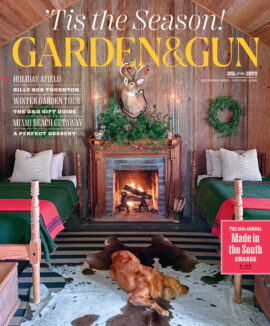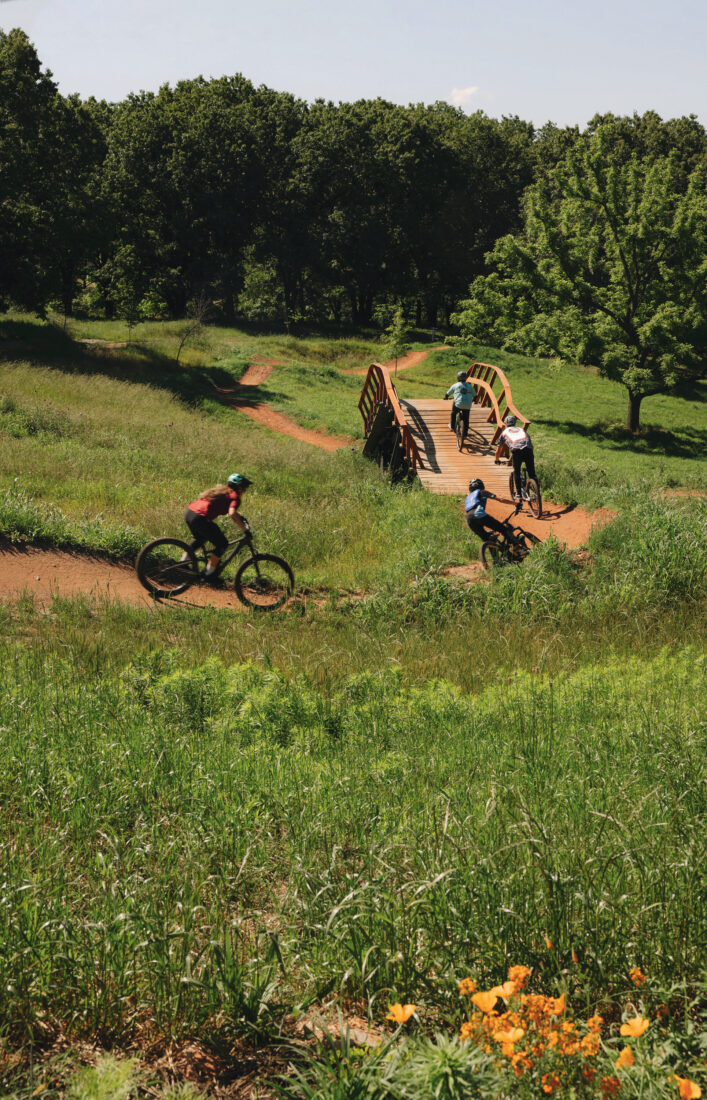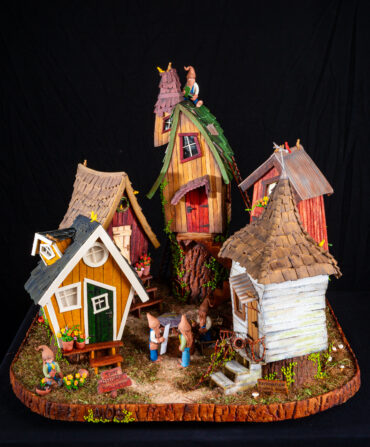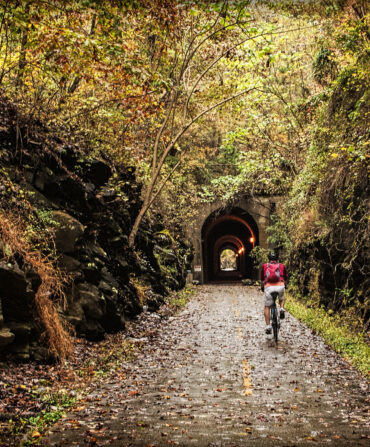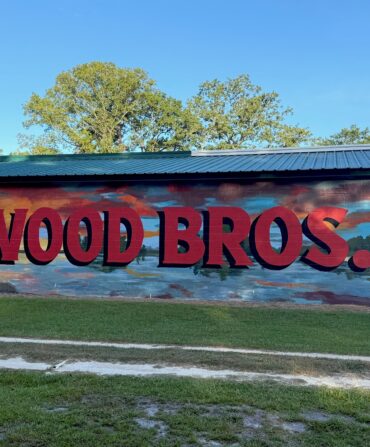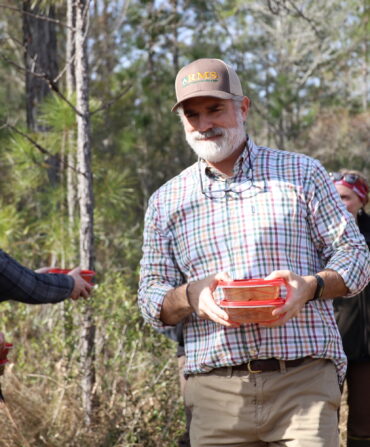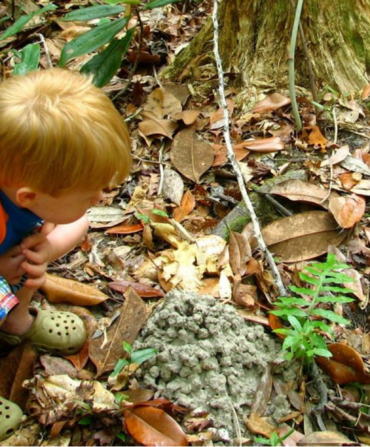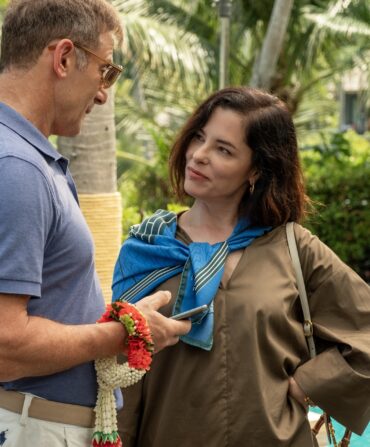“The guy with the hardest job in Bentonville is the one who makes these maps,” says the veteran mountain biker, coach, and guide Sam Pearson with a laugh, as he wheels to a stop in front of a trailhead sign with endless lines and loops denoting biking trails. “By the time a new map comes out, we’ve built more trails and it’s already changed.”
In Northwest Arkansas, a region anchored by the metropolitan hubs of Bella Vista, Bentonville, Rogers, Springdale, and Fayetteville, to say biking is having a moment would be quite the understatement. With Bentonville as the focal point, getting around on two wheels—and partaking in the thriving art scene—is a way of life here. Over the past two decades, Tom and Steuart Walton, grandsons of Walmart founder Sam Walton, have championed the mountain biking cause, funneling some $74 million through the Walton Family Foundation into the creation of 163 miles of bike routes, collectively called Oz Trails.
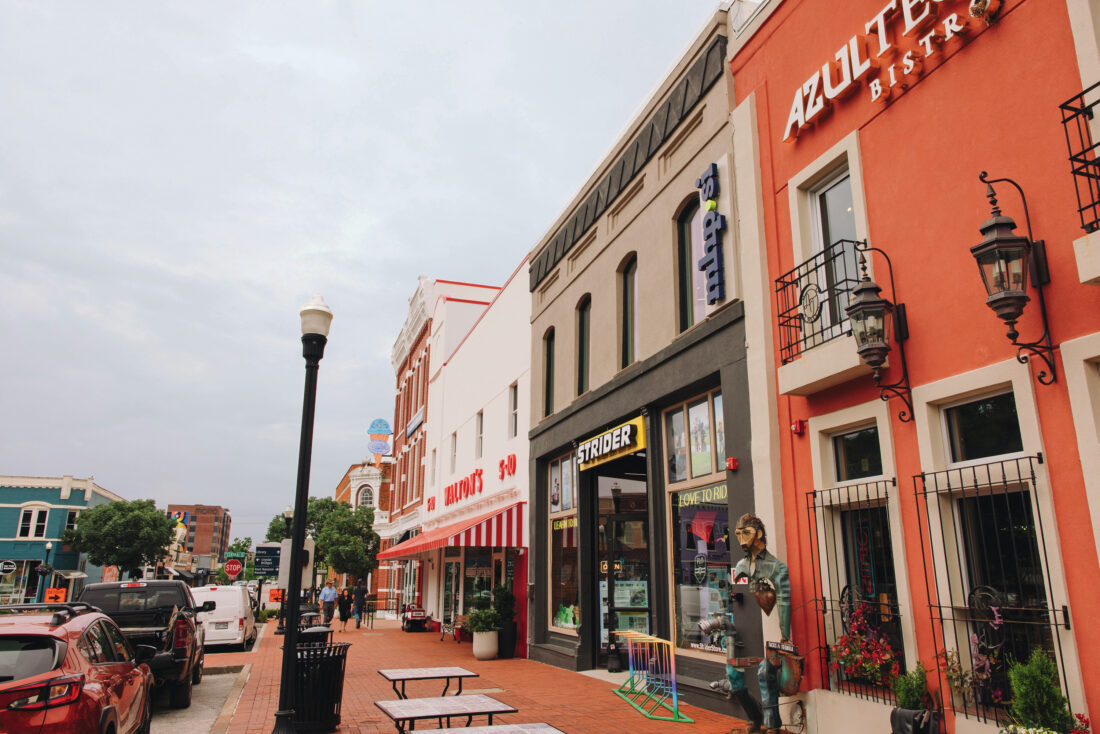
“People refer to Bentonville as the Disneyland of mountain biking,” says Nickel Potter of Phat Tire Bike Shop, the city’s first such enterprise, which opened in 2007 and today boasts fourteen locations. “The infrastructure is just over-the-top cool.” Undulating paths flow into ramps, gap jumps, ladder bridges, and boardwalks that weave through the Ozark Mountains—a setting anointed with near-perfect biking conditions. The ancient, eroded formation offers steep hills without the grueling elevation change of, say, the Rockies; the ground is naturally gravelly, meaning rain rarely closes trails; and relatively mild weather means year-round adventure potential.
So, despite never having ridden a mountain bike in my life, I’ve driven up from my hometown of Little Rock (many cities, including Charlotte and Atlanta, offer direct flights to the Bentonville airport) and rented one from Phat Tire to see what all the buzz is about. I’ve selected electric, to help compensate for my lack of both experience and stamina, and because Northwest Arkansas is one of the few places in the country that allow e-bikes on most trails.
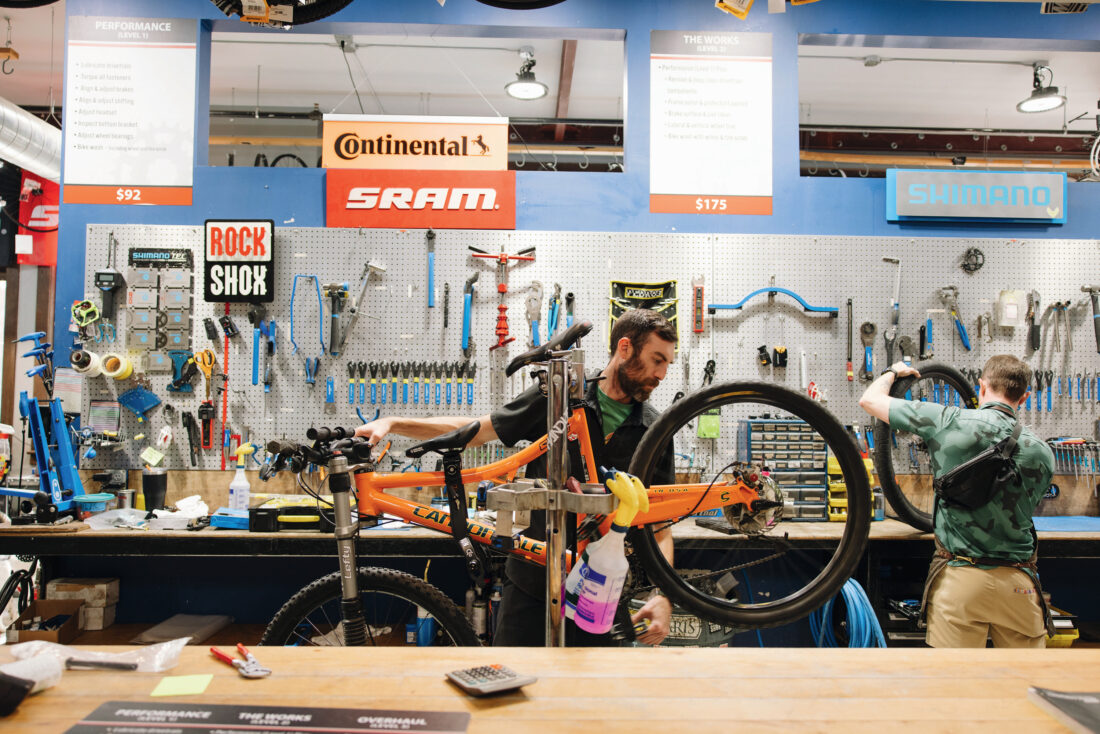
Pearson, my guide, served on the advisory board that shaped the region’s trails. He is retired but sometimes leads rides with Ozark Bike Guides, and now, in a field by the trailhead, I’m getting a crash course in how to stand up off the seat and balance my feet on the pedals to create a spongy, flexible base for bumps and turns. After a few practice spins, we’re off into Slaughter Pen, the original trail system that ignited the biking boom.
Biking here, I quickly learn, is a build-your-own adventure. If you want to ride on pavement, the Razorback Greenway is a smooth forty-mile trail that connects the region’s population centers. If you want to veer off the asphalt, the options rank from easy green to expert-level double black diamond. Soon we are sailing down the All-American Trail, a sloping green that even a first-timer can tackle—though opportunities abound to increase the difficulty by hopping your bike up onto little ramps and over rocks if you’re so inclined (I am not). As we ride toward the heart of Slaughter Pen, the catalyst behind Bentonville’s art scene lies in the ravine below us: Crystal Bridges Museum of American Art.
The museum opened its doors in 2011, the three-pronged vision of Sam Walton’s daughter, Alice Walton, to create a world-class cultural destination marrying art, architecture, and nature. Can’t-miss pieces in the permanent collection include Norman Rockwell’s Rosie the Riveter, a Hudson River School landscape by Asher B. Durand titled Kindred Spirits, and Jimson Weed/White Flower No. 1, a large-scale floral by Georgia O’Keeffe. For architecture enthusiasts, there’s the building itself, a masterwork of curving concrete, glass, wood, and copper hugging the hillside, plus a Frank Lloyd Wright house that sits on-site. “We want visitors to have an art experience that is intertwined with their biking experience,” says Jill Wagar, the museum’s senior director. To that end, the campus’s five miles of bike-friendly trails seamlessly connect to the Razorback Greenway.
Just a short ride away is the Momentary, Crystal Bridges’ younger, hipper, more music-focused sibling, housed in a former Kraft cheese factory. There, bands like Alabama Shakes and Muscadine Bloodline play live, and this summer, an exhibition of photographs from Arkansan Johnny Cash’s concerts at Folsom and San Quentin prisons is on display.
Art manifests beyond Crystal Bridges, too, at times blurring the line between sculptures and trail system. Take the Masterpiece: This rideable piece of art looks like a giant conveyor belt. We watch as a rider zooms over metal ramps and rocks and soars through the air on a spectacular bridge jump. From there, we head over toward the Castle. This starts with a slow-burn climb up to the Castle itself, a circular rock structure from which paths of varying difficulty flow. I find it hard to appreciate the Castle route—or the young mountain bikers flying like missiles over its many jumps—thanks to the fact that I managed to accidentally turn off my pedal assist on the way up and can no longer breathe.
Then it’s time to leave Slaughter Pen, the most urban section of trails, and head a couple miles west of downtown Bentonville. The paved, mercifully flat ride over to the forested, three-hundred-acre Coler Mountain Bike Preserve provides recovery time to soak up the shade of the oaks and hickories and keep an eye (and ear) out for warblers of all sorts, peregrine falcons, and redheaded woodpeckers.
We descend into the valley at Coler—pausing to watch a skilled, brave, or simply foolish soul taking on a double black jump trail called Drop the Hammer—and end up at the Airship, a coffee shop that crops up out of nowhere. This gathering spot, which looks sort of like a concrete shoebox stranded in the forest, is reachable only by bike or foot, and people sit outside by the dozen sipping coffee and cold beers. More trails swirl around us, including Fire Line, a favorite among more serious riders, and a lovely pair of green routes that we meander on called Family Flow and Good Vibrations. Then it’s time to head back into town and close out back where we started, in downtown Bentonville.
“Before, you could throw a dead cat across this square and not hit anybody,” Pearson says as we speed toward Phat Tire. Not so today. Bikes fill the racks on the corners. People spill out the front door of the newly renovated Walmart Museum, which tells the story of how Sam Walton built at that very site his first general store—which would launch the international chain that would change the world and continues to shape this city. Boutiques lining the street stock Arkansas-made products; my favorite is a gallery called Art on the Square where the artists themselves are often present and available to chat about their work.
There are plenty of choices for a celebratory meal, thankfully all in easy walking distance, even on my post-ride wobbly legs. I grab a picnic table at Yeyo’s cheerful yellow food truck for a quick trio of pork carnitas tacos and green chile queso from James Beard Award semifinalist chef Rafael Rios, whose standout Mexican food has become a Northwest Arkansas darling. Another great dinner option: the Preacher’s Son, in a converted church just a block off the square. The soaring interiors, stained glass, and art—look carefully, one of the paintings has an abstract bicycle in it—are matched in loveliness by the pimento cheese croquettes and the new rooftop bar, Celeste. Locals also sip tropical cocktails at Callisto and flock to eat tapas at Bar Cleeta, barbecue at Wright’s, and sushi at a new spot called Junto.
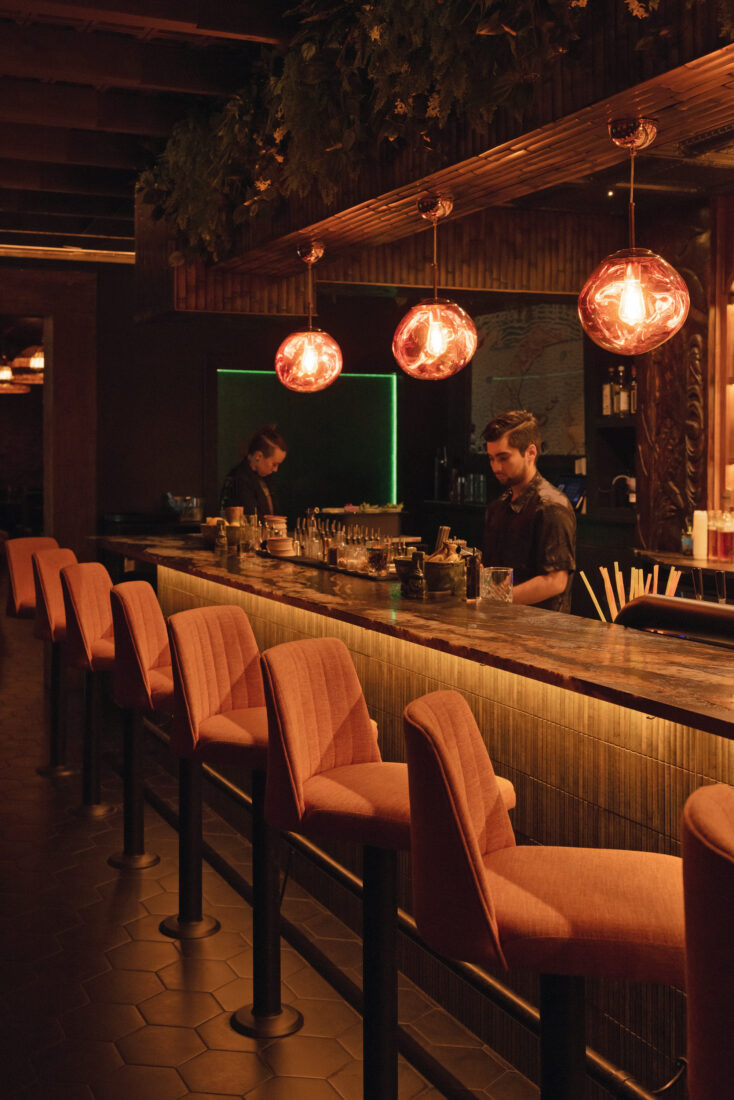
But my preferred dinner comes from the Hive. Started by chef Matt McClure and now led by Micah Klasky and housed in the gallery-meets-hotel 21c, the restaurant has an ever-changing menu that showcases Arkansas-grown ingredients. To kick things off, I order a Cocchi Rosa spritz and the seasonal welcome bite. “It’s meant to be a snapshot of the moment,” Klasky says—in late summer, for example, fresh cantaloupe wrapped in house-cured ham and drizzled in chili oil. “I don’t let the calendar tell me what I serve,” he says. “I let the fields tell me.” Pretty much everything is made in-house, including the charcuterie, of which Klasky is particularly proud. (The Hive also uses an AI trash can to track what’s getting tossed so the staff can reduce waste.) I love the crunchy Brussels sprout salad, crumbly cornbread, and grilled Berkshire hog chop, and the fact that Klasky, of course, bikes to the farmers’ market and to work.
The next morning, as I walk from the square toward Crystal Bridges after grabbing a latte at Onyx Coffee Lab, I pass the same spot where we started our adventure the day before, sorry to be on foot this time as bikers fly past. I notice a small sticker on the trailhead sign that I didn’t see yesterday: IF YOU BUILD IT THEY WILL BIKE.


